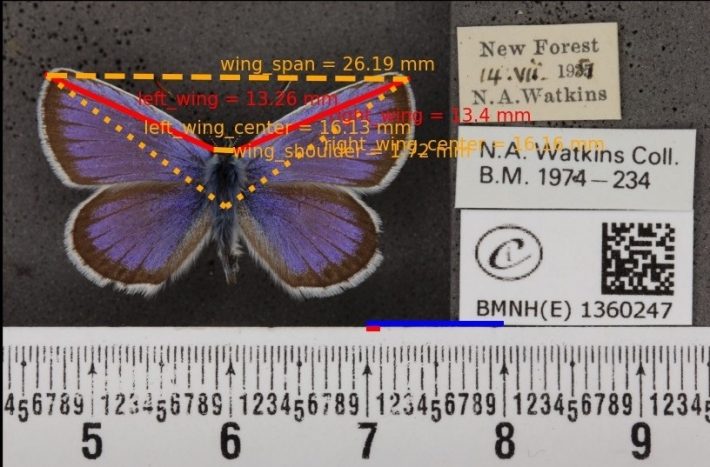Natural History Museum press release.
New study published in Methods in Ecology and Evolution is one of the first to to show that computer vision can accurately measure physical characteristics from digital collections and test species' responses to climate changes.

An international team from London's Natural History Museum, the University of Southampton and the Berkeley Institute for Data Science at the University of California have used the Natural History Museum's digitised butterfly collections to evaluate the impact of climate change on British butterfly species size. The most common findings suggest that adult butterfly body size increase with temperature during the late larval stages of development.
The research was conducted on one of the largest butterfly collections in the world - the Natural History Museum's collection which has approximately 125,000 specimens. Digitisation of these species has enabled this advancement in scientific research into the impact of climate change on wild species.
Computer vision is a rapidly evolving field in which computers are programmed to identify and measure information from digital images or video. Researchers at the Berkeley Institute for Data Science developed a computer vision pipeline called 'Mothra' and with this, they were able to analyse over 180,000 photographed specimens from the Natural History Museum's iCollections project. The oldest specimen used in this project dates from the early 1900s.
The Natural History Museum's British and Irish butterfly and moth collection is the oldest, largest, and most diverse of its kind in the world
Mothra automatically detects the specimen and measures characteristics including wing features (such as length), orientation (how the specimen is pinned) and identifies the sex. This process substantially reduces the time required to analyse individual specimens, which would otherwise require researchers to physically measure and record manually. Results from this study indicated that there was a near perfect relationship between Mothra and manual measurements.
"The Natural History Museum's British and Irish butterfly and moth collection is the oldest, largest, and most diverse of its kind in the world." Says, Geoff Martin, Senior Curator in Charge (Lepidoptera) at the Natural History Museum London. The process of digitisation involves transforming the physical information into a digital photographic format.
The Natural History Museum has so far digitised over five million specimens and released these openly on the Museum's Data Portal including over 776,000 butterflies and moths which can be freely accessed globally.
Scientists paired measurements with monthly temperature records experienced by the immature stages of 24 different British butterfly species and looked for patterns in the relationship between size and temperature. Both the Natural History Museum's collections and temperature records span many decades and provide a large amount of data, making them ideal sources for temperature-size response studies.
Out of the 24 species analysed, 17 showed significant results, correlating increased adult size with increase in temperature during late larval stage. The impact of temperature on other larval stages were non-significant and varied between female and males of the same species.
Our study has shown the value and power of digitisation and machine learning to rapidly release this wealth of evidence, which can be used to conserve species in a changing world.
This study highlights the value of digitising natural history specimens to help our understanding of species' responses to climate change. Alongside digitisation efforts by museums, technological advancements in computer vision are enabling scientific research to be conducted more rapidly and efficiently than ever before. These aspects are proving to be a powerful tool in aiding wild species conservation efforts and mediating the impacts of climate change on species both on a local and global scale.
Stephen J Brooks, Entomology Researcher at the Natural History Museum London and coauthor on the paper says; "Natural history collections contain information on how the natural world responds to change through time. But the sheer size of these collections often makes it difficult to extract this information.
"Our study has shown the value and power of digitisation and machine learning to rapidly release this wealth of evidence, which can be used to conserve species in a changing world."
Dr Phillip B Fenberg, Lecturer from the University of Southampton and co-author on the paper says; "Our paper is among the first to show that computer vision can be applied to these digital images for testing hypotheses on how animals may respond to climate change. This is accelerating our understanding of how the biosphere will react to climate change."
Dr Stéfan J van der Walt, Researcher at Berkeley Institute for Data Science and co-author on the paper says; "The open-source scientific Python ecosystem made it possible to rapidly develop software which accurately and automatically analyses digital specimens, an otherwise laborious manual process.
The international collaboration also benefited from being a small, cross-disciplinary team–having both field and software expertise. We are delighted that the research is based around open data and software, allowing others to verify and build upon our work."
You can read the full article here:
https://besjournals.onlinelibrary.wiley.com/doi/abs/10.1111/2041-210X.13844






